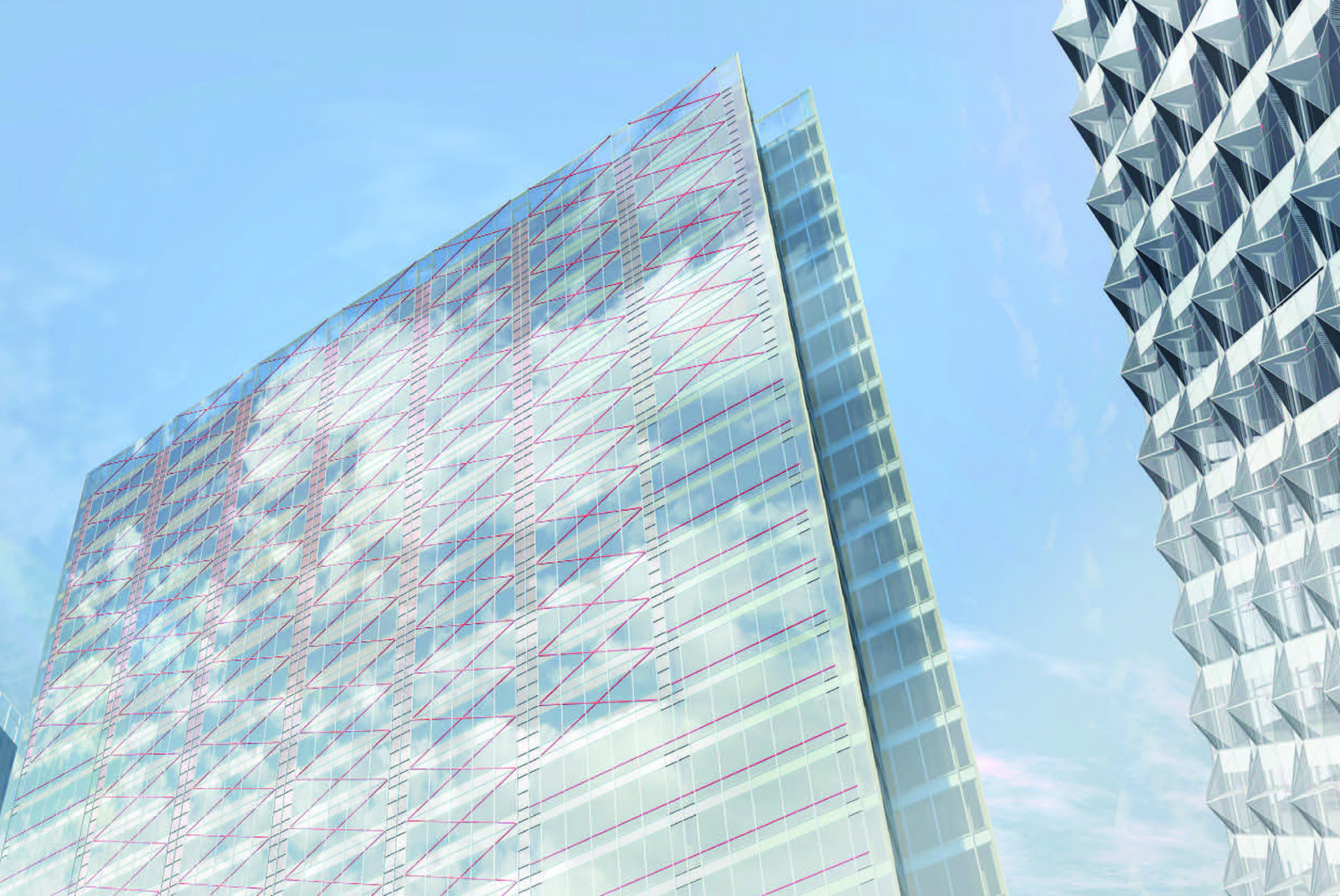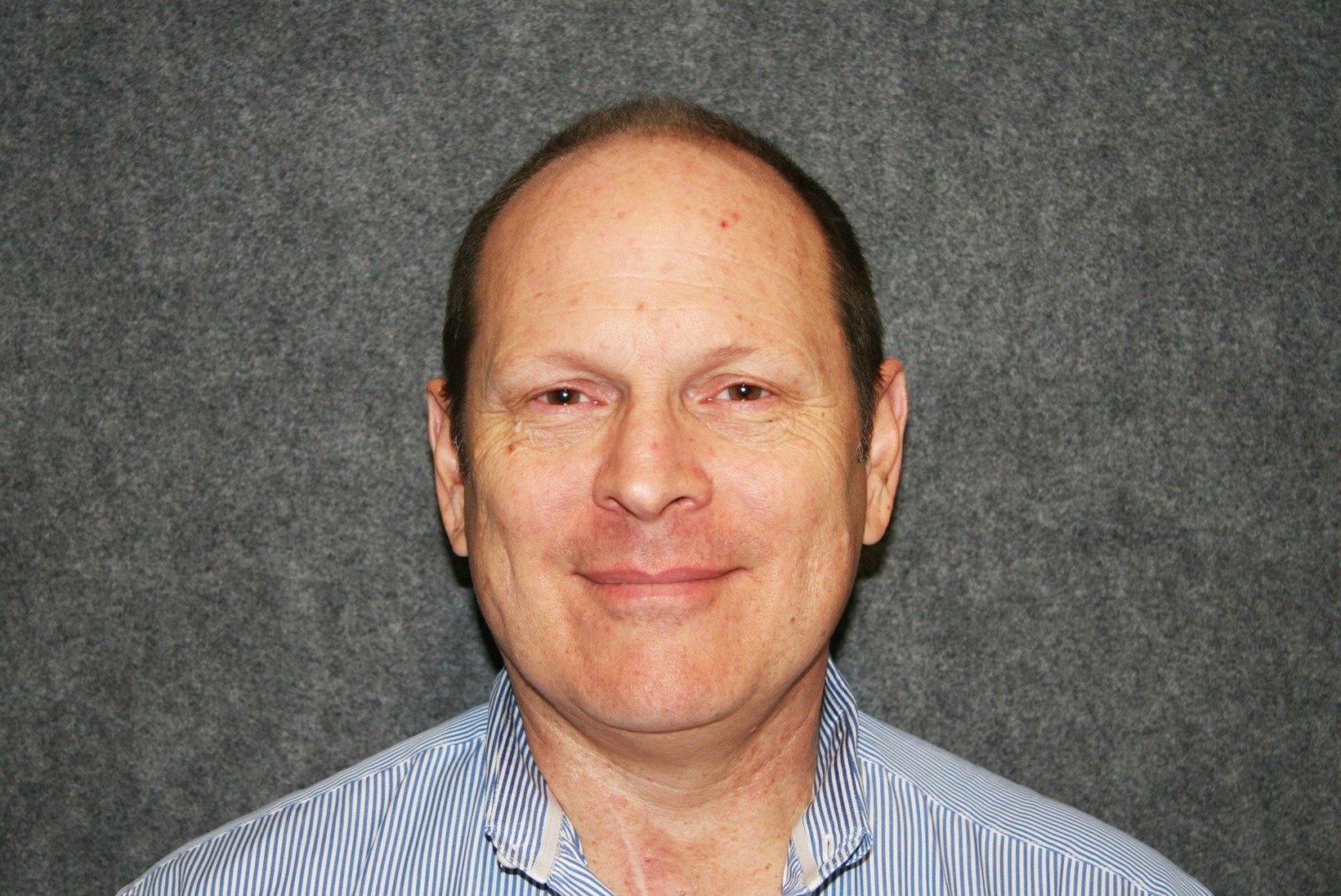John Neary, a senior facade specialist in HOK’s New York office, has spent years as both a professor and designer researching and exploring building exteriors.
Recently one of Neary’s designs, a load-bearing hybrid curtain wall concept called Structural eXterior Enclosure, was named a finalist in the Metals in Construction Design Challenge for building ideas that reduce embodied energy.
Neary’s structural cladding, designed with his HOK colleagues, replaces much of the aluminum found in standard curtain walls with steel and incorporates a steel X-brace behind the glazing to enable the facade to contribute to the wind resistance of the building. The load-bearing Structural eXterior Enclosure concept reduces the amount of steel framing required in a high-rise tower. Since the steel framing in the enclosure requires roughly one-third the amount of carbon to produce as aluminum, its use further contributes to lowering the embodied energy of the building by as much as 20 percent. Thermal modeling suggests that the design—imagined to fill an entire bay with each prefabricated panel—could also improve U-value by 25 percent as it would have fewer seams than traditional curtain walls. And its steel structure is less conductive than aluminum, which minimizes potential thermal bridging.
What spawned your idea for this structural skin?
JN: This work grew out of an abiding interest in the aesthetic importance of structure, a subject I started working on 15 years ago when I taught at Washington State University. I was interested in using the enclosure to augment the primary structural frame of a high-rise building, rather than it being a conventional non-load-bearing curtain wall. Apart from the general aesthetic and intellectual attractions of integrating these elements, this suggests material efficiency. A measure of that which will become increasingly important is embodied energy, which we measure in terms of embodied carbon dioxide.
To make the nominally 8-inch deep exterior of a typical multistory building contribute anything significant to the primary structure requires that the typical aluminum mullions be replaced with steel for its greater strength. And steel represents much less embodied energy—energy spent in manufacture—than aluminum per ton. Though steel is heavier than aluminum by volume, the greater strength of steel allows for comparatively smaller elements. Suffice to say steel mullions mean less embodied carbon dioxide, and it illustrates the important point that simply considering the amount of material will not necessarily result in the most environmentally sustainable design. Yet I still believe that doing more with less, in principle, is a good place to start. This study of making the enclosure a structural skin was an attempt to realize a straightforward way of doing more with less material.
Your award submittal offers great detail on the evolution of steel frame buildings and curtain walls. Did anything in that research surprise you or confirm a truth you already knew?
I was most surprised by the extreme efficiency of how we currently create steel structures in buildings. It is a reflex these days to talk about innovation as if the conventional ways we do things were somehow the product of thoughtless habit, but they are not. Lloyd Kahn, one of the creators of the Whole Earth Catalog, wrote something regarding domes and post-and-beam houses on this theme in the 1970s, when the first environmental movement in architecture was underway. Having become disillusioned with domes, he said if it made economic sense to build houses on those models, builders would be doing it.
Likewise, the structural frame and the non-load-bearing curtain wall enclosure represent an extremely economical way to design and build, with a Fordist division of labor affording flexibility and speed in construction. Still, many of the most thoughtful and influential architects of the modern era have explored integrating structure and enclosure: from Jean Prouvé, Le Corbusier and Buckminster Fuller experimenting with stressed metal skin, to Mies and the Second Chicago School using steel mullions engaged with the perimeter of the building frame, to I.M. Pei and Araldo Cossutta making structural concrete facades in systems-inspired shells that preceded the structural tubes of John Skilling, Myron Goldsmith and Fazlur Khan.
The motive behind each of these was a combination of an aesthetic belief in the rightness of integrating things, as in natural objects and systems, and a conviction that buildings should be built to last. We are coming to grips with this point today. As net-zero-energy-producing buildings are becoming a reality, the entire measure of environmental impact will be their embodied energy. The greenest building is the one that is already built. Buildings of the past, which tended to be solid and have bearing walls and exposed structures, generally have lasted longer than newer ones. Even the early high-rise buildings, in which masonry cladding over steel frames formed a composite type of construction that created fireproofed and laterally braced framing, have fared better in terms of durability than post-war buildings with lightweight curtain wall.
The structural skin idea is an attempt to preserve the advantages of the curtain wall and achieve the material utility of the structural shell. Perimeter tubes in tall buildings are not more common because they require thick walls with limited openings. The structural skin concept is, in a way, a densification of the structure of the braced tube, integrating enclosure into the most efficient structural frame system.
The structural elements of the enclosure are under glass, creating a combination of continuous surface with minimal interruption and visible detail articulation that animates the facade—while thermal performance is optimized.
How did you and the team arrive at the design for Structural eXterior Enclosure?
The schemes that Simon Shim, HOK senior project engineer, and I studied at the outset were all based on the stick-framed grid of steel tubes that I had initially researched and that we developed in a paper we did for the Facade Tectonics Institute conference in the fall of 2016. That paper, Structural Skin, was actually referenced in the program for the Metals in Construction competition.
It was at the beginning of the competition, when we were trying to address the issue of the great weight of steel in the enclosure schemes, that we considered making the largest panels possible–with the fewest number of tubes taking only compression and diagonals taking tension. Though it now seems like an obvious thing to do, most exterior wall systems are based on 5-foot-wide units, the dimension relating to the standard office planning grid and norms for glass sizes relating to availability, handling and cost. Larger prefabricated panels were fairly common on exterior walls in the early days of curtain walls, in the 1950s, and in the ‘70s and ‘80s when precast concrete and then stone veneer on steel panels were popular.
There are obvious advantages to large panels in terms of minimizing the number of pieces, of ‘picks’ to lift them on to the building and maximizing shop fabrication. Yet for the past 20-30 years or so, prefab panels have largely fallen out of fashion. We’re now starting to see that change a bit, especially as digital fabrication processes become more mainstream. I believe sustainability and efficiency of construction will also push designers and builders to consider using them more.
What does this project say about HOK?
It says that we enjoyed designing this as an exercise in refining a simple idea we believed in, and we naturally enjoy working collaboratively across disciplines to come up with new design solutions. Unlike several of our competitors in the Metals in Construction competition, we could draw on our interdisciplinary practice—engineers, architects, sustainability experts, facade specialists—to do everything in house. I’ve really enjoyed working on this with all my HOK colleagues, which in addition to Simon included Matt Breidenthal, regional leader of engineering, as well as several younger architects who helped with the presentation.
Will the structural skin move from theory to reality?
I believe our work will become a reality. Structural enclosure is not a new idea—just one that has been out of the mainstream throughout the modern period. The imperative of greater material efficiency for the sake of environmental sustainability and the increasing ease of analyzing this kind of hybrid structure—and of prefabricating the components due to advances in digital technology—are driving this kind of design. There are many prominent projects around that employ forms or facade details that appear to be structural, though most are not. We are naturally attracted to structural form, and to detail that expresses the way things work.
When I was a design director at a previous firm, I had hoped to use a preliminary version of this idea on a speculative office building. That didn’t pan out, but it is so close to the way industrial buildings are built that it seems obvious it could work. I am looking for another opportunity to prove it.

